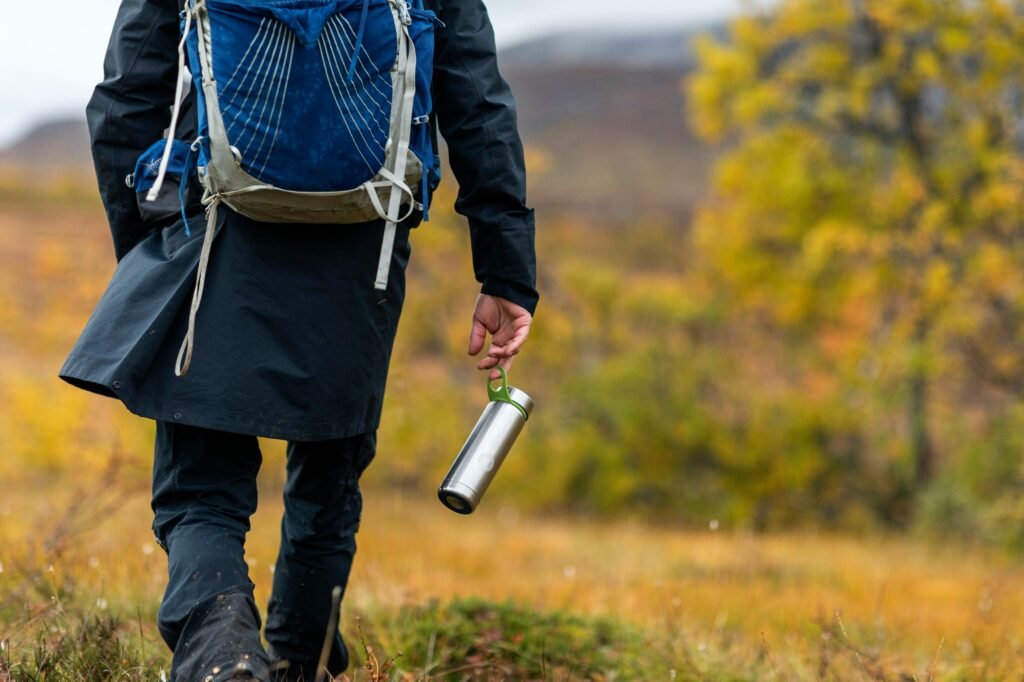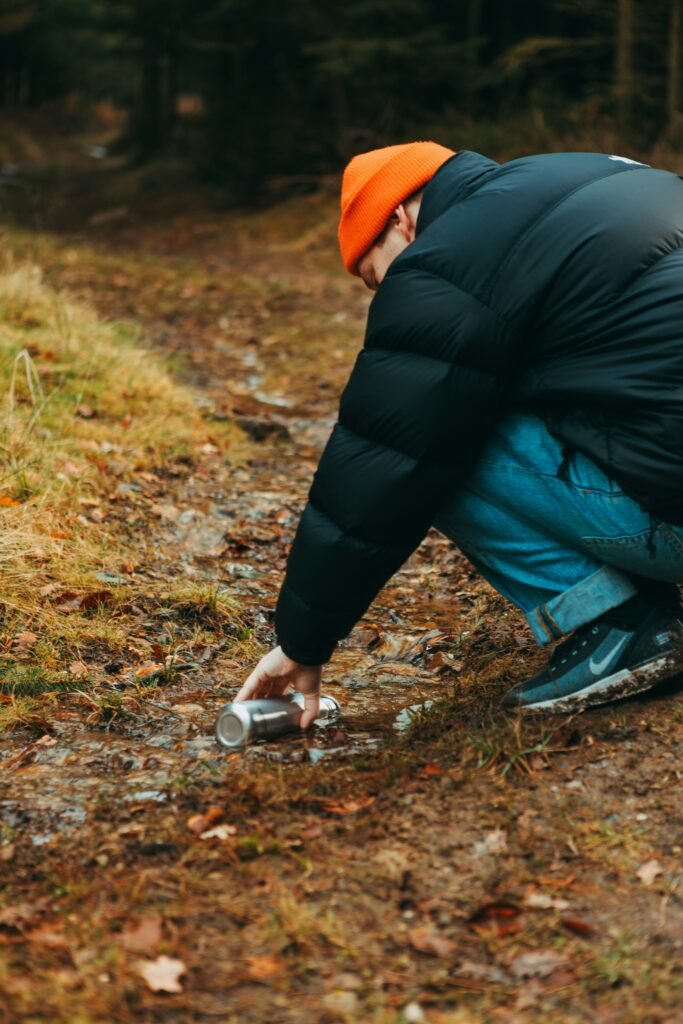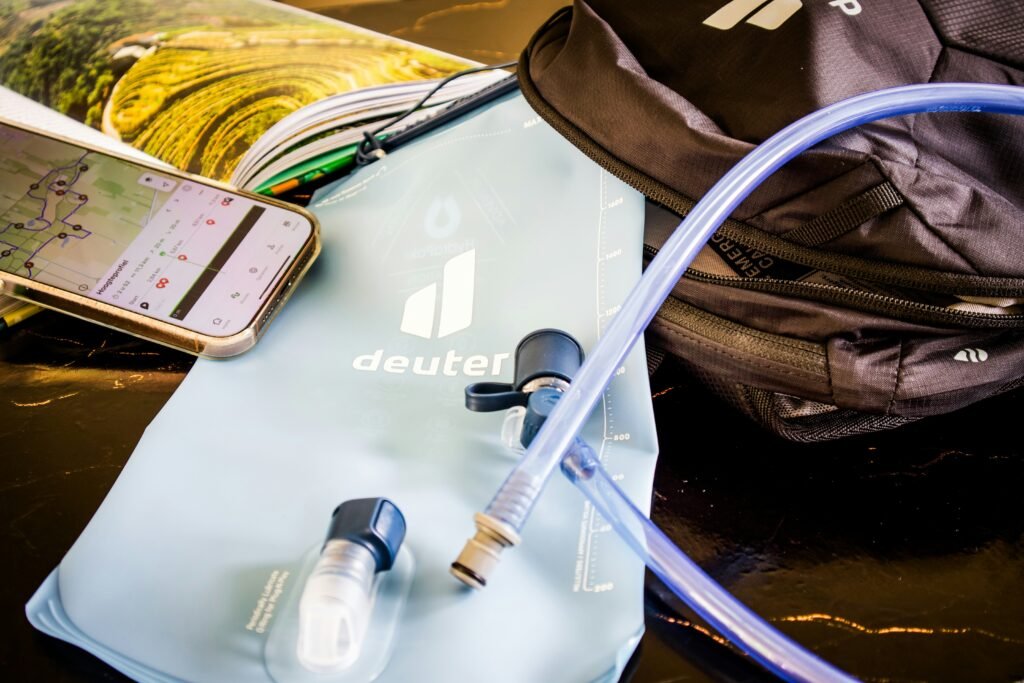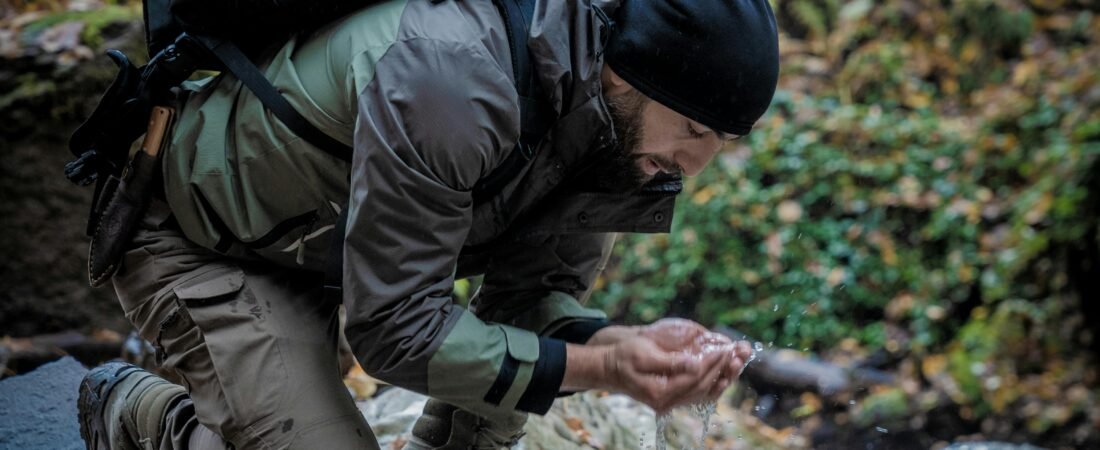Last updated: August 2025
Ever had a headache, on a trail? Trust me, Dehydration and it’s consequences—whether you’re aware of it or not—can turn a fun hike into a miserable experience. Proper hiking hydration isn’t just about dragging a huge bottle; it’s about understanding how much water hiking truly requires and learning smart strategies to stay hydrated while hiking. In this guide, we’ll cover practical tips, personalized guidelines, and real-world experiences to keep you safe, comfortable and healthy on every outing. This is your Complete guide to staying hydrated while hiking – from water requirements to gear recommendations. So, let’s get into it!
Table of Contents
*This post may contain affiliate links. If you use them, I may earn a small commission at no extra cost to you.
Why Proper Hydration Matters for Hikers
I am personally prone to getting migraines from dehydration on a regular day, so I have to be extra mindful when hiking. Dehydration on the trail isn’t just uncomfortable—it’s dangerous. When you’re hiking, your body works harder than during everyday activities. You’re engaging larger muscle groups, often at elevation or in challenging weather, sometimes while carrying a heavy backpack.
Even mild dehydration (losing just 2% of your body weight in fluids) can cause:
- Headaches and dizziness
- Blurred vision
- Muscle cramps and fatigue
- Reduced endurance and performance
- Impaired judgment and decision-making
- Increased risk of heat exhaustion
If you want to read More on dehydration.
Proper hiking hydration helps maintain your energy, mental clarity, and safety throughout your adventure.
How Much Water Do You Need While Hiking?
The standard recommendation is 0.5 to 1 liter (16-32 oz) per hour of moderate hiking, but your actual needs depend on several key factors.
Factors That Affect Your Water Requirements
1. Hike Duration and Distance
- Short day hikes (2-4 miles): 1-2 liters total
- Full-day hikes (6-10 miles): 3-4 liters total
- Long-distance hikes (10+ miles): 4-6+ liters total

2. Elevation Gain Climbing increases your heart rate and breathing, accelerating water loss. A 2,000-foot (around 600 meters) elevation gain can double your fluid needs compared to flat terrain.
3. Weather Conditions
- Hot weather (80°F+, 26°C): Increase intake by 25-50%
- Humid conditions: Add an extra 16-24 oz (0,5-0,7 L) per hour
- Cold weather: Don’t forget to hydrate—you still lose fluids through respiration, though it may be less noticeable.
4. Individual Factors
- Body weight and fitness level
- Personal sweat rate
- Backpack weight (heavier packs = more exertion)
Calculating Your Hiking Water Needs
Example calculation for a 6-hour moderate hike:
- Base requirement: 0.75L per hour
- Total needed: 0.75L × 6 hours = 4.5 liters
- Hot weather adjustment: +25% = 5.6 liters total
If math is not your friend, give this hiking water calculator a try.
Practical carrying strategy:
- 3L hydration bladder + two 1L bottles
- Plan water refill points along the trail
Pre-Hike Hydration Strategy
Proper hydration starts well before you hit the trail.
24-48 Hours Before Your Hike
- Drink 2-3 liters of water daily
- Monitor urine color—aim for light yellow
- Avoid excessive alcohol or caffeine (draw out the liquids)
Morning of Your Hike
- Drink 16-20 oz of water 1-2 hours before starting
- Add electrolytes to your morning hydration
- Check urine color one final time
Pro tip: I learned this lesson the hard way during one of my hikes. I was in a rush, so I didn’t drink much in the morning. Ended up with a pounding headache by mile 2. Now I start drinking water as soon as I wake up on hiking days. (and any other day to be honest)
Smart Hydration Tips During Your Hike
The “Sip, Don’t Gulp” Rule
Drinking large amount in one go might make you pee it out faster. Therefore drink small amounts frequently rather than large quantities at once. Aim for 3-4 sips every 10-15 minutes—don’t wait until you feel thirsty. This is where a bladder with a straw is helpful. Unlike using a bottle, you can sip without stopping to get out and open a bottle. Plus with a bladder you don’t need to tilt your head – less danger of misplacing your foot.
Monitor Your Hydration Status
Signs of proper hydration:
- Light yellow urine
- Moist mouth and lips
- Steady energy levels
- No headache or dizziness
Dehydration warning signs:
- Dark yellow urine or no urination for 4+ hours
- Dry mouth and sticky saliva
- Headache, dizziness, or fatigue
- Muscle cramps
Emergency Dehydration Protocol
If you notice dehydration symptoms:
- Stop hiking and find shade immediately
- Sip water with electrolytes slowly
- Rest for 15-30 minutes
- If symptoms persist, consider turning back
Best Practices for Trail Hydration (tips)
- Mark your water containers with volume measurements
- Use insulated bottles to keep water cool in hot weather
- Freeze one bottle overnight for refreshing cold water mid-hike
- Set phone reminders to drink regularly
Finding and Treating Water on the Trail
For longer hikes, you’ll likely need to refill from natural sources.

Water Treatment Methods
1. Water Filters (Recommended)
- Best options: Sawyer Squeeze, Katadyn Hiker Pro
- Pros: Removes bacteria and protozoa, lightweight
- Cons: Requires time to filter
2. Purification Tablets
- Best options: Aquamira, Potable Aqua
- Pros: Ultra-lightweight, inexpensive
- Cons: 30+ minute wait time, metallic taste
3. UV Purifiers
- Best options: SteriPEN Ultra
- Pros: Quick treatment (48 seconds)
- Cons: Requires batteries, doesn’t work in murky water
Safety tip: Always treat water from natural sources, even if it looks clean. Fill up whenever you encounter a reliable water source—don’t wait until your supply runs low.
Best Hiking Hydration Gear
Hydration Systems
Hydration Bladders (Best for Long Hikes)
- CamelBak Crux 2-3L: Easy-sip valve, quick-fill design
- Osprey Hydraulics 3L: Durable, great for multi-day trips
- Platypus Big Zip 3L: Wide opening for easy cleaning
Water Bottles (Best for Day Hikes)
- Nalgene 32oz Wide Mouth: Virtually indestructible
- Hydro Flask 32oz: Excellent insulation
- Smart Water 1L: Lightweight, fits most filters
Electrolyte Supplements
Tablets and Powders
- Nuun Sport: Balanced electrolytes, low sugar
- LMNT: High sodium for hot weather hiking
- Liquid IV: Quick hydration boost
- Tailwind Nutrition: All-in-one hydration and fuel
Understanding Electrolytes and Why They Matter on the Trail
When you sweat during a hike, you don’t just lose water—you also lose electrolytes, which are minerals that help keep your body’s fluid balance, nerve signals, and muscle function working properly. If you only replace water without electrolytes, you risk diluting your body’s balance, which can lead to fatigue, cramps, headaches, or even more serious conditions like hyponatremia.
The key electrolytes important for hikers are:
- Sodium – The main electrolyte lost in sweat. It regulates fluid balance and helps muscles contract. Without enough sodium, you may feel weak, dizzy, or cramp-prone.
- Potassium – Works with sodium to maintain muscle function and prevent cramps. It also helps your body store energy.
- Magnesium – Supports muscle relaxation and energy production. A lack of magnesium can contribute to soreness or twitching after long treks.
- Calcium – Essential for muscle contractions and strong bones. Even small imbalances can cause fatigue or coordination issues.
- Chloride – Often paired with sodium as “salt,” it helps regulate fluid balance and digestion.
On most day hikes, your body can manage with water and a balanced diet before and after the trail. But on longer treks, in hot conditions, or during strenuous climbs, electrolyte replacement becomes just as important as water. Sports drinks, electrolyte tablets, powders, or even salty snacks can help keep your system balanced and your energy steady.
Special Conditions: Cold Weather and High Altitude Hiking
Cold Weather Hydration
Since it is cold and you don’t sweat as much, it may seem that you don’t want to drink as much. However, you can still get dehydrated in cold weather, so proper hydrating techniques are just as important.
- You lose water through respiration in cold, dry air
- Set hourly reminders to drink—you won’t feel as thirsty
- Keep water bottles inside your jacket to prevent freezing
- Warm drinks can be more appealing and encourage fluid intake
High Altitude Hydration (8,000+ feet)
- Increased breathing rate accelerates fluid loss
- Drink 1.5-2x your normal water intake
- Watch for altitude sickness symptoms
- Consider electrolyte supplements to maintain mineral balance
Post-Hike Recovery and Rehydration
Your hydration needs don’t end when the hike does. It is important to restore lost liquids and minerals. Plus your body will need to use fluids for post-hike muscle and whole body recovery.
Immediate Post-Hike (First 2 Hours)
- Drink 150% of the fluid you lost (weigh yourself before/after if possible)
- Choose drinks with electrolytes: coconut water, chocolate milk, or sports drinks
- Eat water-rich foods: watermelon, oranges, soup
Recovery Tips
- Continue drinking regularly for 4-6 hours post-hike
- Monitor urine color—should return to light yellow within 4 hours
- Avoid alcohol until you’re fully rehydrated
Pro tip: don’t forget post hike stretches for recovery too. It is not just food or liquids that your body needs.
Common Hiking Hydration Mistakes to Avoid
- Waiting until you’re thirsty – Thirst is a late indicator of dehydration
- Drinking only water – Long hikes require electrolyte replacement
- Chugging large amounts at once – Can cause stomach cramps and nausea
- Underestimating cold weather needs – You still lose significant fluids in winter
- Ignoring individual factors – Your needs may differ from general recommendations
- Forgetting to pre-hydrate – Starting dehydrated makes recovery much harder
more mistakes to avoid while hiking: 10 Common Beginner Hiking Mistakes (And How to Avoid Them)

Hiking Hydration FAQ
How much water should I drink while hiking?
A common guideline is about 0.5 liters (17 oz) per hour of moderate hiking in mild weather. In hotter conditions or on steep climbs, you may need closer to 1 liter per hour.
Should I drink only when I’m thirsty?
Not always. Thirst is a late signal—by the time you feel it, you may already be dehydrated. It’s better to sip small amounts regularly instead of waiting until you’re very thirsty.
What’s the best way to carry water?
Hydration bladders are great for sipping on the go, while water bottles are simple and easy to refill. Many hikers bring a combination of both.
Do I need electrolytes or just water?
For hikes under two hours, water usually does the job. On longer, hotter, or more strenuous hikes, electrolytes (via sports drinks, powders, or salty snacks) help replace what you lose through sweat and prevent cramps or fatigue.
How can I tell if I’m dehydrated?
Signs include dark urine, headaches, dizziness, fatigue, or muscle cramps. If you notice these, stop, rest, and rehydrate before continuing.
How do I know if I’m overhydrating?
Drinking too much plain water without electrolytes can cause hyponatremia, a dangerous drop in sodium levels. Symptoms include nausea, confusion, bloating, or headaches. To prevent this, balance water with electrolytes on longer hikes.
Can I just drink from streams, rivers or lakes?
Only if you purify the water. Even clear-looking mountain streams can carry bacteria, parasites, or viruses. Use a water filter, purifier, or tablets to make it safe.
How should I plan my hydration for a hike?
Pre-hike: Start well-hydrated by drinking water beforehand.
During hike: Sip steadily, about 2–4 gulps every 15–20 minutes.
Post-hike: Rehydrate with water plus electrolytes or a balanced meal.
How many liters of water do I need for one person on a day hike?
For a full-day hike (6–8 hours), plan on carrying 2–3 liters per person. If it’s very hot, strenuous, or there’s no chance to refill, bring more—up to 4 liters may be necessary.
Is drinking while hiking a choking hazard?
Not really if you sip slowly. Hydration bladders are designed for safe, hands-free sipping while moving. Chugging large gulps while on steep or uneven terrain could make you cough, so keep it steady and controlled.
Conclusion: Master Your Hiking Hydration
Proper hydration isn’t just about carrying more water—it’s about carrying water smartly and drinking consistently throughout your adventure. By understanding your personal water needs and following these evidence-based strategies, you’ll stay energized and safe on any trail.
Remember: consistent hydration is best strategy for enjoying longer, more challenging hikes. Start hydrating before you feel thirsty, pack the right gear for your adventure, and always have a backup plan for water resupply.
Ready to put these hydration tips into practice? Check our
- Hot weather hiking: How to Survive Hiking in Summer,
- Hiking Nutrition: What to Eat Before, During & After for Best Performance and
- How to Train for Hiking? a Long-Distance and Elevation-Heavy Hike Complete 2025 Guide
- How to Start Hiking: A Beginner’s 12 Step Guide for more expert advice on safe, enjoyable hiking adventures.

Leave a Reply to How to Start Hiking: A Beginner's 12 Step Guide – Hike Before Destination Cancel reply